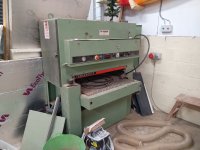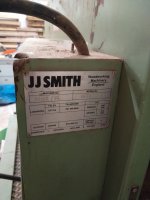Hi
I'm a carpenter who does cabinetry work mainly, but I'm no expert when it come to mechanical matters.
I got a belt sander from JJ Smith, fixed it up, got it running (after it had been sitting for at least a year) and I have done a few jobs using it.
Unfortunately it has developed this issue where it dosen't always oscillate the sand paper belt backwards and forwards and just shreads it after traveling too far one way.
I believe I have identified the part that is the issue as shown in the photos.
It's an air based piston. The piston is pushed out when the input of air is switched and the reverse, depending on the side the paper is on.
This piston will not always make the switch now, it'll work only sometimes and only if I encourage it. Almost like it's sticking, just not making the switch inside. I can tell the input of air is changing so it is an internal issue.
Does anyone know how this can be fixed or a place where I can get a replacement part from?
Thanks
Jack
I'm a carpenter who does cabinetry work mainly, but I'm no expert when it come to mechanical matters.
I got a belt sander from JJ Smith, fixed it up, got it running (after it had been sitting for at least a year) and I have done a few jobs using it.
Unfortunately it has developed this issue where it dosen't always oscillate the sand paper belt backwards and forwards and just shreads it after traveling too far one way.
I believe I have identified the part that is the issue as shown in the photos.
It's an air based piston. The piston is pushed out when the input of air is switched and the reverse, depending on the side the paper is on.
This piston will not always make the switch now, it'll work only sometimes and only if I encourage it. Almost like it's sticking, just not making the switch inside. I can tell the input of air is changing so it is an internal issue.
Does anyone know how this can be fixed or a place where I can get a replacement part from?
Thanks
Jack




